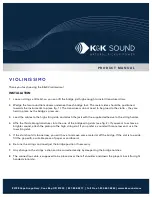
1. LASER SAFETY
1.1. LASER TYPES
There are different types of lasers according to the medium of photon propagation (gas, solid, liquid,
etc.) contained inside the laser tube and the excitation mechanism used to cause the laser process. As a
result, laser emissions of different wavelengths (energy content and power) are obtained. The risks from
exposure to laser emission are different for each type of laser. According to the features mentioned
above, lasers are categorized into 4 classes and their Accessible Emission Limit (AEL) is specified as
follows.
•
Class I
. Lasers which are inherently safe or safe due to their design.
•
Class II
. Low output power device which give out visible emission (400nm ≤ λ ≤ 700nm) and can
work in continuous or pulsed mode. For exposure times up to 0.25 seconds, the output power of
these systems is limited to the AEL of Class I. For exposure times longer than 0.25 seconds, the
limit is 1mW.
•
Class IIIA
. Continuous emission lasers that have an output power to 5 mW or five times the Class II
limited for pulsed and swept lasers. Regarding the remaining spectral ranges, emissions should not
exceed five times the AEL of Class I.
•
Class IIIB
. Continuous emission lasers which cannot exceed 0.5W and the emission exposure to
pulsed lasers must be less than 105 Jm-2.
•
Class IV
. High power devices which exceed AEL of Class IIIB.
1.2. LASER SAFETY STANDARDS
The laser marking system is fitted with basic safety features at the point there might be risk of laser
emission if the allowed AEL limit is exceeded.
The laser marking system is equipped with a protective casing which, except for the laser aperture,
prevents human access to laser emission exceeding Class I.
Class IIIB and IV lasers (except for those of Class IIIB which do not exceed five times the Class II AEL
limit at a wavelength of 400nm to 700nm) will emit an audible or visual warning when the power source
is activated.
Any part of the laser protective casing which, when removed or
replaced to be repaired, would imply exposure to excessive
emission, requires the use of tools. This prevents exposure to
excessive laser emission in relation to the assigned AEL limit.
The safety interlock is designed to prevent the removal of the panel
until the accessible emission values are lower than the AEL of the
assigned class.
NOTE
Laser marking system protection covers can only be removed by using tools.
1-1 •LASER TYPES







































